Johannes Kottonau and Claudia Pahl-Wostl (2004)
Simulating political attitudes and voting behavior
Journal of Artificial Societies and Social Simulation
vol. 7, no. 4
<https://www.jasss.org/7/4/6.html>
To cite articles published in the Journal of Artificial Societies and Social Simulation, reference the above information and include paragraph numbers if necessary
Received: 18-Dec-2003 Accepted: 09-Jun-2004 Published: 31-Oct-2004
 Abstract
AbstractUnderstanding the dynamics of attitude formation is a key issue in social psychology. The paper presents a computational model for simulating the formation and change of attitudes and the influence of the strength of attitudes on behavior. The main conceptual challenge was to capture not only the traditional attitude concept but the full concept of attitude strength. This required combining different theoretical approaches within an integrated modeling framework. The dynamics of political attitudes of German citizens were chosen as specific application area because of the considerable amount of empirical data available. The model was tested by simulating the effects of different voting campaign strategies on the outcome of an election. Uncertainties in model parameters were accounted for by using Monte Carlo simulations. The implications of specific theoretical assumptions were investigated by performing model simulations for different model structures.
The paper shows the potential of social simulation when it comes to bringing together different theoretical approaches. The integration within a model exposes gaps and inconsistencies and allows formulating hypotheses for further empirical investigations.
The model has a modular structure and provides a rich repository for other modelers who are working in the field of attitude simulation.
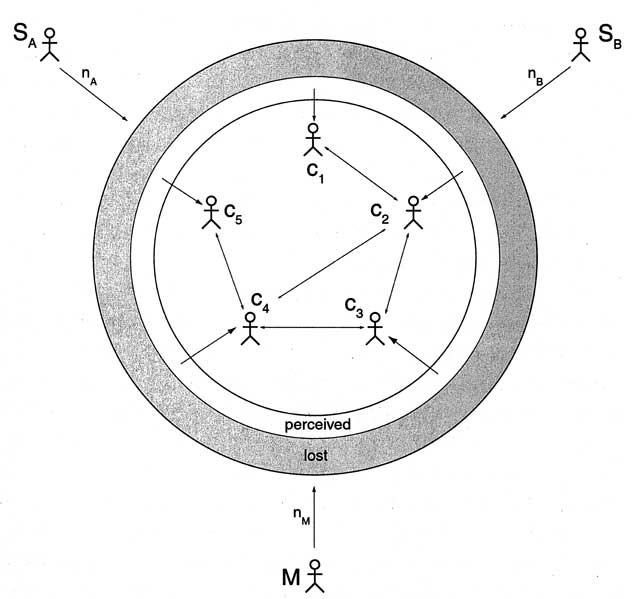
|
| Figure 1. Overview of the social level. The center of the graph depicts a citizen network representing five citizens c1 to c5. In each time step, the citizens perceive a fraction of persuasive messages from the "campaign arena" depending on their habitual interest in the elections (the light ring denotes "perceived" messages, whereas the dark ring denotes "lost" resp. not perceived messages). In each time step, the strategists SA and SB and the mass media M post a specific number ni of persuasive messages on the campaign arena according to their temporal campaign strategy. |
The strategists and the mass media represent external sources of persuasive messages released in the form of TV news and spots, newspaper articles and ads, brochures, bumper stickers etc. These persuasive messages permanently affect the attitude formation and communication process of the citizens (see figure 1).
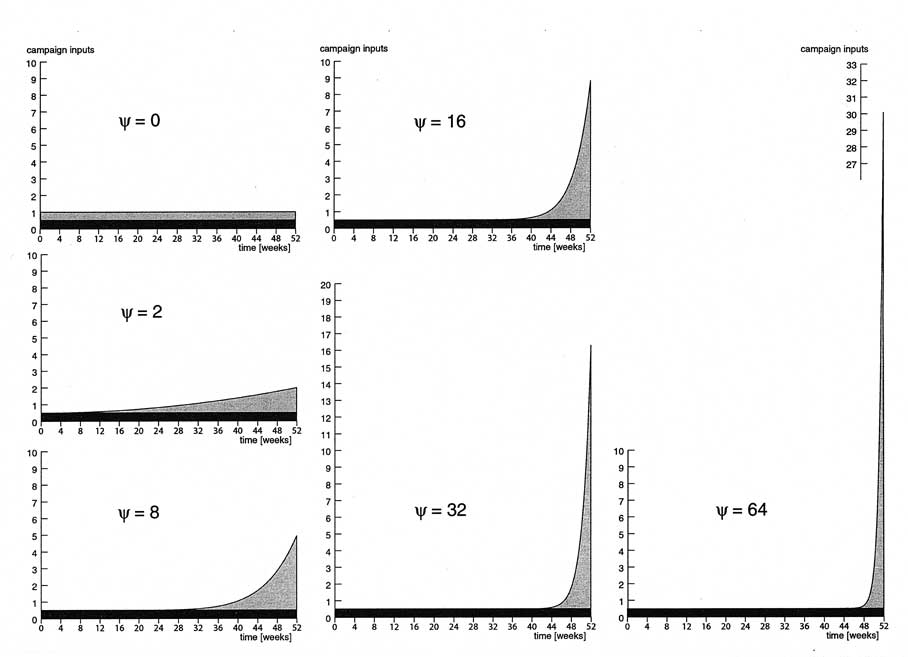
|
| Figure 2. Increasing degrees Ψ of accumulating half of the budgeted party advertising activities (light area) during one year before voting day. The other half of the budget (dark area) is spent for permanent party advertising activities (baseline campaigning) |

|
(1) |

|
(2) |

|
(3) |
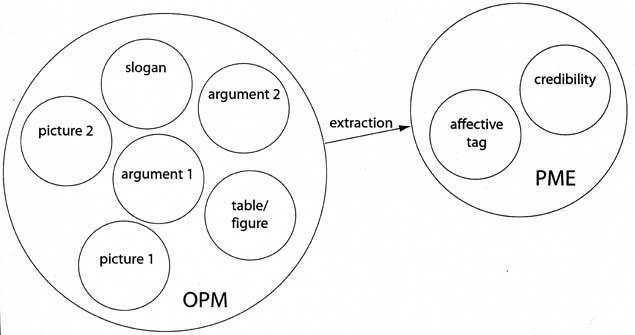
|
| Figure 3. At the moment of perceiving an Original Persuasive Message (OPM), its full content is translated into the Persuasive Message Extract (PME) |
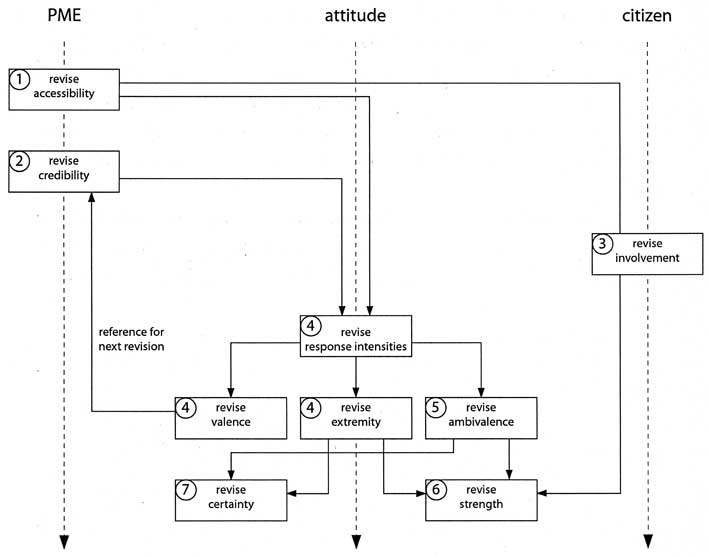
|
| Figure 4. Overview of the temporal sequence of the various steps that are performed if a citizen has encountered new evidence. The numbers of the boxes correspond to the numbers of the steps used in the section headers in the text. The dashed lines denote the temporal evolution at the three levels of the Persuasive Message Extracts (PMEs), the citizen's attitude and the citizen. The arrows denote the inputs required for a particular step |
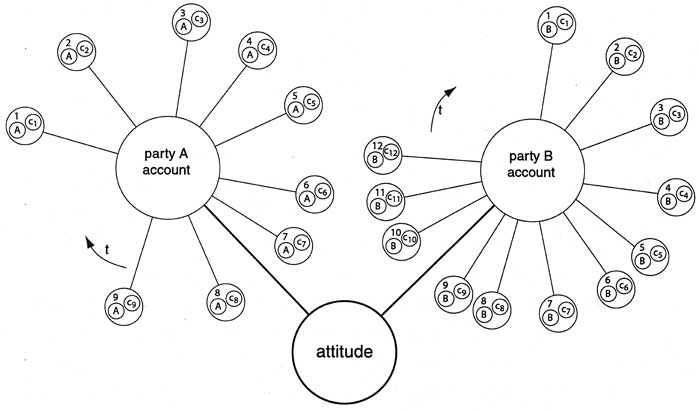
|
| Figure 5. The attitude unit is divided into two basic memory accounts. Every account is associated to steadily growing sets of PMEs (circles at the end of the spokes) that have been perceived during the ongoing campaign. The affective valences A or B and the credibility ci of PME i are indicated as two small circles within the circle indicating the PME |

|
(4a) |

|
(4b) |

|
(5a) |

|
(5b) |

|
(6a) |

|
(6b) |

|
(6c) |
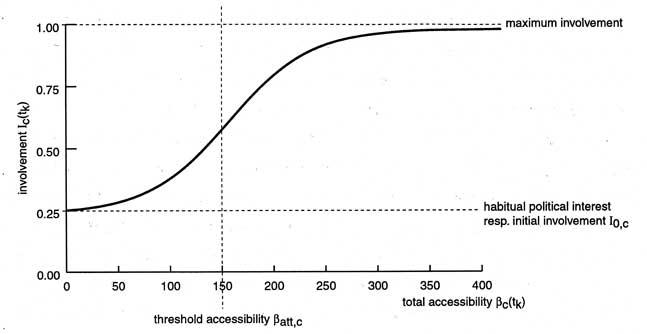
|
| Figure 6. If citizens perceive persuasive messages with some minimal frequency, the total accessibility of all PMEs β c(tk) in the accounts is steadily growing. This overall measure for the recent frequency of campaign activities in the campaign arena is translated into the citizen involvement. Each citizen has an individual threshold of accessibility β att,c that determines the moment of getting significantly attentive to the campaign activities |

|
(7a) |

|
(7b) |

|
(8) |

|
| Figure 7. Processes involved in the revision of the attitude Ac(tk) of citizen c at time tk after new evidence was encountered from the campaign arena. The two circles represent the two party accounts. The index i of each PME denotes its position within the temporal sequence of perception (high numbers for recent PMEs). The most recent PMEs are more accessible (bold lines), whereas older PMEs are less accessible (thin lines). Episodes that were perceived in situations of interpersonal communication (IPC) are most accessible. According to their accessibilities ai(tk) and credibilities ci(tk), the PMEs of each account are separately integrated into the response intensities RA,c(tk) and RB,c(tk). Finally, the response intensities are transformed into the attitude Ac(tk) and the party ambivalence Πc(tk). |

|
(9a) |

|
(9b) |

|
(10a) |
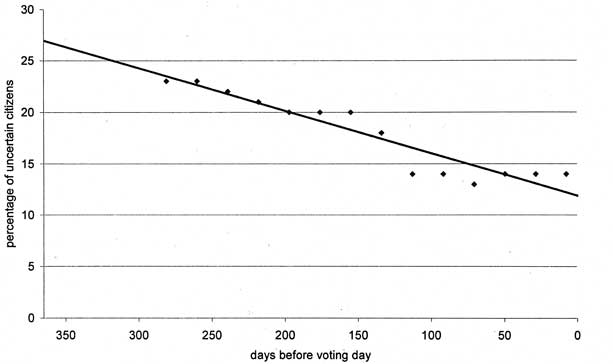
|
| Figure 8. Decreasing percentage Δ (tk) of uncertain citizens when asked which party they would vote for if voting day were today. Data (dots) from Erhardt (1998), extrapolation (line) by the author |

|
(10b) |
The state label "uncertain" is attached to the Δ(tk) percent out of all citizens with the lowest certainty at time step tk. Due to this categorization, an attitude of a particular citizen can flip between "certain" and "uncertain" several times during the simulated year depending on her/his position in certainty ranking.
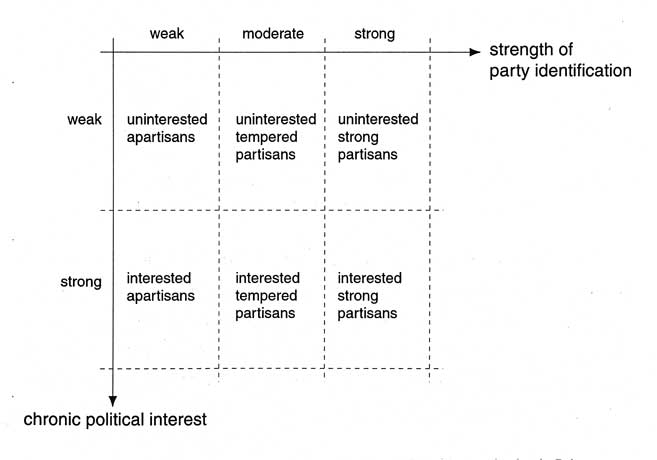
|
| Figure 9. Citizen types distinguished in the model. The two dimensions are related to the Dalton (1984) typology of citizens. |
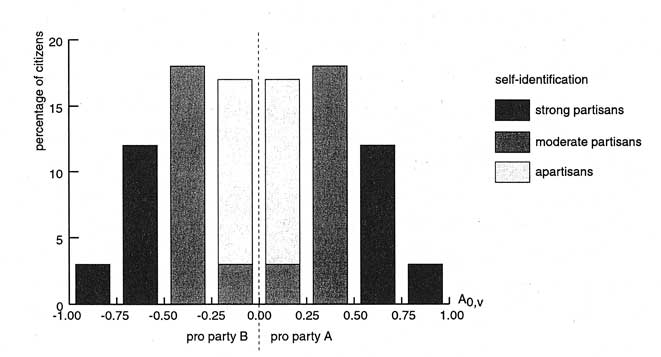
|
| Figure 10. Distribution of initial attitudes among 100 citizens in the simulation experiments. Reading example: 17% of the citizens have an initial attitude extremity between 0.00 and 0.25 and a pro party A valence. When asked for their party identification, 14 % of them report that they do not identify themselves with any party, whereas only 3% translate the relatively small extremity into the answer "tempered partisan" |

|
(11) |

|
(12) |

|
(13) |
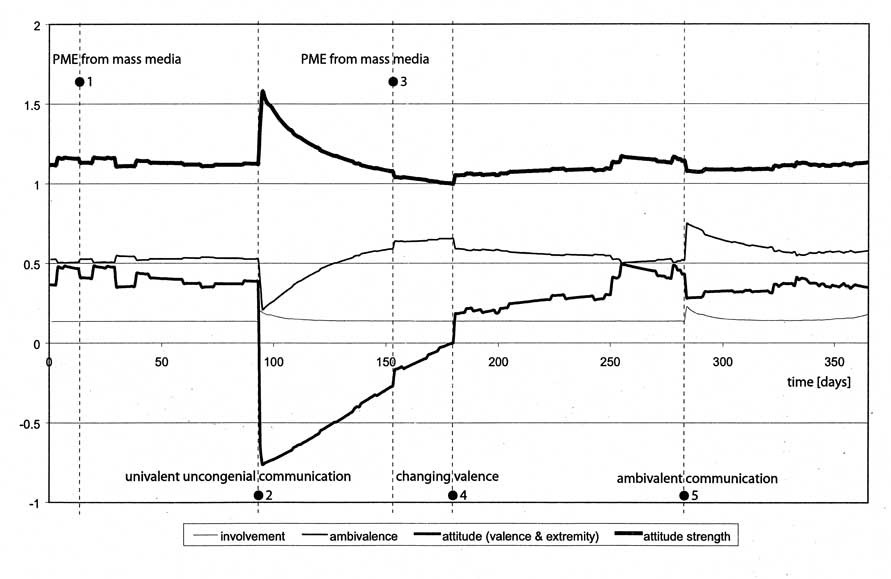
|
| Figure 11. Time plots of the various characteristics of attitude strength (and attitude strength itself). The figure is an example of how the model's output on the level of one particular citizen. The x-axis is divided into the 365 days before voting day. The y-axis shows the relative values of the different attitude components. On day 93, this citizen gets in contact with a strong supporter from the opponent party. The initial attitude of the receiver is almost immediately converted (one has to know that the ambivalence of this citizen is relatively high compared to the average citizen in the model). However, the impact of this conversion is not lasting very long. After some 100 days the citizen might think: "Three months ago, I felt completely convinced by my colleague, but now I feel quite sure again that I have always been right." |

|
| Figure 12. Overview of the volatility of the electorate encompassing 100 citizens (the temporal trace of the preference of each citizen is represented as a horizontal line) during the 365 days before voting day. The vertical position of every citizen depends on his/her initial attitude valence and extremity (between -1 for extreme support of party B, +1 for extreme support of party A, and near 0 for apartisans). Blue color means that, on a particular day, this citizen is supporting party A, red color means that this citizen is supporting party B. In this example model run, party A is advertising relatively early, while party B concentrates on strong accumulation with a big final burst. Window 1 shows the early advertising of party A yielding a considerable number of initial apartisans near the zero extremity line, while window 2 documents the final burst of party 2 regaining almost all of these citizens shortly before voting day. |
| Table 1: Structural and parametrical attributes of the experiments 1 to 4 | ||
| speed of memory decay | RAS-A2 absent | RAS-A2 present |
| high | experiment 1; Ψopt,1 | experiment 2; Ψopt,2 |
| low | experiment 3; Ψopt,3 | experiment 4; Ψopt,4 |

|
(14) |
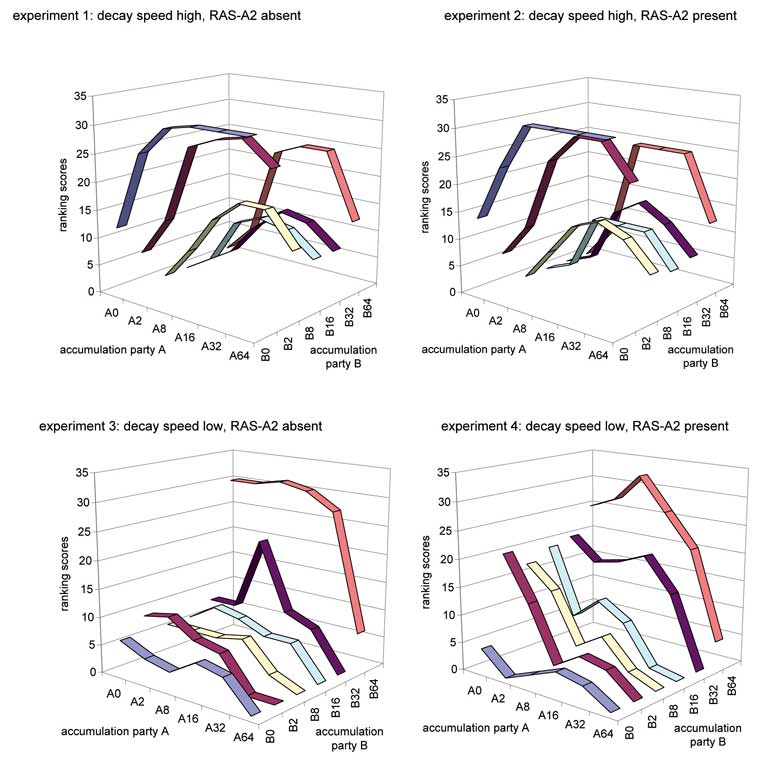
|
| Figure 13. Strategy ranking scores for the 6 × 6 strategy encounters in each of the four experiments. Generally, the higher the winning probability of party A under a specific strategy encounter of the opposite parties A and B, the higher is the relative ranking score for that strategy encounter (see text) |
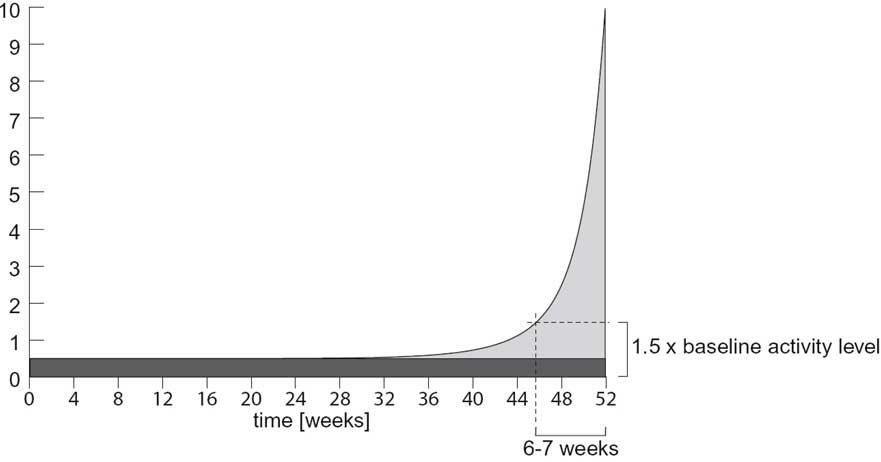
|
| Figure 14. The optimal degree of accumulating campaign resources towards voting day under the condition of high memory decay and the presence of the second axiom from the Receive-Accept-Sample (RAS-A2) model (Zaller 1992) |
| Table 2: Possibilities of simplifying the model by omitting specific model components. The modeler has to decide if the loss of psychological detail is relevant to her/his project | |
| Omitted Model component | Loss of psychological detail |
| simulation of suppressing or elevating the credibilities of new persuasive messages depending on their congeniality of the receiving citizen | Human attitude bolstering "The opposite is not very credible." The dramatic nature of the moment of conversion "Since today I see everything from a different angle." |
| simulation of the temporal decay of persuasive messages | Recency effects typical for information integration under low involvement Antagonism between an initial attitude anchor and short-term conversion "One week ago, I felt completely convinced by my colleague, but now I feel quite sure again that I have always been right." |
| simulation of the ambivalence and involvement component of attitudes | Attitude-behaviour link "First, I feel very certain about my opinion and second, I am really curious in the outcomes of the election. So, for me it is obvious to participate in the election." |
| simulation of the involvement component of attitudes | Attention to advertisements I am really not interested in the elections. Even if I notice something about the parties, it is instantaneously forgotten". Communication behaviour "I am really curious in the outcomes of the election. I will start a discussion with Paul this evening." "I feel very sure about my opinion; it will be easy to convince Paul." |
AVERY R. K. and T. A. McCAIN (1986), "Interpersonal and Mediated Encounters: A Reorientation to the Mass Communication Process". In G. Gumpert and R. Cathcart (Eds.), Inter/media. Interpersonal Communication in a Media World, New York, Oxford University Press, pp. 120-131
BARGH J. A., S. CHAIKEN, R. GOVENDER and F. PRATTO (1992), "The generality of th automatic attitude activation effect". Journal of Personality and Social Psychology, Vol. 62, pp. 893-912
BASSILI J. N. (1995), "Response latency and the accessibility of voting intentions: What contributes to accessibility and how it affects vote choice". Personality and Social Psychology Bulletin, Vol. 21, pp. 686-695
BERELSON B. R., P. F. LAZARSFELD and W. N. MCPHEE (1954), Voting. A Study of Opinion Formation in a Presidential Campaign. Chicago, University of Chicago Press
BOBROW D. G. and D. A. NORMAN (1975), "Some principles of memory schemata". In D. G. Bobrow and A. Collins (Eds.), Representation and understanding, New York, Academic Press.
BRECKLER S. J. and E. C. WIGGINS (1991), "Cognitive Responses in Persuasion: Affective and Evaluative Determinants". Journal of Experimental Social Psychology, Vol. 27, pp. 180-200
BURNKRANT R. E. and A. G. SAWYER (1983), "Effects of involvement and message content on information processing intensity". In R. J. Harris (Eds.), Information processing research in advertising, Hillsdale, NJ, Lawrence Erlbaum Associates
BURSE J., (2000) 'Quicksilver: A Component-Based Environment for Agent-Based Computer Models and Simulations'. CASOS Presentation, Carnegie Mellon University, Pittsburgh, 23. July 2000. http://dolly.interway.ch:8100/hp/quick00/quicksilver.pdf
CACIOPPO J. T., W. L. GARDNER and G. G. BERNTSON (1997), "Beyond bipolar conceptualizations and measures: The case of attitudes and evaluative space". Personality and Social Psychology Review, Vol. 1, pp. 3-25
CHAIKEN S., A. LIBERMAN and A. H. EAGLY (1989), "Heuristic and systematic processing within and beyond the persuasion context". In J. S. Uleman and J. A. Bargh (Eds.), Unintended thought, New York, Guilford, pp. 212 - 252
CONVERSE P. E. (1970), "Attitudes and non-attitudes: Continuation of a dialogue". In E. R. Tufte (Eds.), The quantitative analysis of social problems, Reading, Addison-Wesley, pp. 168-189
DALTON R. J. (1984), "Cognitive Mobilization and Partisan Dealignment in Advanced Industrial Democracies". Journal of Politics, Vol. 46, pp. 264-284
DOLL J. and I. AJZEN (1992), "Accessibility and stability of predictors in the theory of planned behaviour". Journal of Personality and Social Psychology, Vol. 63, pp. 754-765
DULANY D. E. (1991), "Conscious representation and thought systems". In R. S. Wyer and T. K. Srull (Eds.), Advances in Social Cognition, Hillsdale, NJ, Lawrence Erlbaum Associates, pp. 97-120
EAGLY A. H., W. WOOD and S. CHAIKEN (1978), "Causal inferences about communicators and their effect on opinion change". Journal of Personality and Social Psychology, Vol. 36, pp. 424-435
EAGLY A. H. and S. CHAIKEN (1998), "Attitude structure and function". In D. T. Gilbert, S. T. Fiske and G. Lindzey (Eds.), The handbook of social psychology, New York, McGraw-Hill, pp. 269-322
EAGLY A. H., P. KULESA, L. A. BRANNON, K. SHAW-BARNES and S. HUTSON-COMEAUX (2000), "Why counter-attitudinal messages are as memorable as proattitudinal messages: The importance of active defense against attack". Personality and Social Psychology Bulletin, Vol. 26, pp. 1392-1408
EPSTEIN S. (1991), "Cognitive-experimental self-theory". In R. Curtis (Eds.), The relational self: Convergences in psychoanalysis and social psychology, New York, Guilford Press, pp. 111-137
ERBER M. W., S. D. HODGES and T. D. WILSON (1995), "Attitude strength, attitude stability, and the effects of analyzing reasons". In R. E. Petty and J. A. Krosnick (Eds.), Attitude strength: Antecedent and consequences, Hillsdale, Erlbaum, pp. 433-454
ERHARDT K. (1998), "Die unentschlossenen Wähler als Motor zyklischer Wahlabsichtsverläufe. Eine Untersuchung am Beispiel der Rückgewinnung der Wähler durch die CDU im Frühjahr 1994". In C. Dörner and K. Erhardt (Eds.), Politische Meinungsbildung und Wahlverhalten, Opladen, Westdeutscher Verlag, pp. 15-118
FALTER J. W., H. SCHOEN and C. CABALLERO (2000), "Dreissig Jahre danach: Zur Validierung des Konzepts 'Parteiindentifikation' in der Bundesrepublik". In M. Klein, W. Jagodzinski, E. Mochmann and D. Ohr (Eds.), 50 Jahre Empirische Wahlforschung in Deutschland. Entwicklung, Befunde, Perspektiven, Daten, Wiesbaden, Westdeutscher Verlag
FAZIO R. H. and M. P. ZANNA (1978), "Attitudinal qualities relating to the strength of the attitude-behaviour relationship". Journal of Experimental Social Psychology, Vol. 14
FAZIO R. H. (1986), "How Do Attitudes Guide Behaviour?" In R. M. Sorentino and T. E. Higgins (Eds.), The handbook of motivation and cognition: Foundations of social behaviour, New York, Guildford Press, pp. 204-243
FAZIO R. H. and C. J. WILLIAMS (1986), "Attitude Accessibility as a Moderator of the Attitude-Perception and Attitude-Behaviour Relations: An Investigation of the 1984 Presidential Election". Journal of Personality and Social Psychology, Vol. 51, pp. 505 - 514
FAZIO R. H., M. C. POWELL and C. J. WILLIAMS (1989), "The role of attitude accessibility in the attitude to behaviour process". Journal of Consumer Research, Vol. 16, pp. 280-288
FELDMAN S. (1989), "Measuring Issue Preferences: The Problem of Response Instability". Political Analysis, Vol. 1, pp. 25-60
FINKEL S. E. and P. SCHROTT (1995), "Campaign Effects on Voter Choice in the 1990 German Bundestag Elections". British Journal of Political Science, Vol. 25(July), pp. 349-377
GESIS, (1996), "Allgemeine Bevölkerungsumfrage der Sozialwissenschaften (ALLBUS). Kumulierter ALLBUS 1980-96"
GREENWALD A. G. and C. LEAVITT (1984), "Audience involvement in advertising: Four levels." Journal of Consumer Research, Vol. 11, pp. 581-592
GREENWALD A. G. and M. R. BANAJI (1995), "Implicit social cognition: Attitudes, self-esteem, and stereotypes". Psychological Review, Vol. 102, pp. 4-27
HASTIE R. and B. PARK (1986), "The Relationship Between Memory and Judgment Depends on Whether the Judgment Task is Memory-Based or On-Line". Psychological Review, Vol. 93, pp. 258-268
HEGSELMANN R., U. MÜLLER and K. G. TROITZSCH (1996), Modelling and simulation in the social sciences from the philosophy of science point of view. Dordrecht, Kluwer
HENDERSON P. W. and R. A. PETERSON (1992), "Mental accounting and categorization". Organizational Behaviour and Human Decision Processes, Vol. 51, pp. 92 - 117
HOUSTON D. A. and R. H. FAZIO (1989), "Biased processing as a function of attitude accessibility: Making objective judgments subjectively". Social Cognition, Vol. 7, pp. 51-66
HOVLAND C. I. and W. WEISS (1951), "The influence of source credibility on communication effectiveness". Public Opinion Quarterly, Vol. 15, pp. 635-650
HUCKFELDT R. and J. SPRAGUE (1993), "Citizens, Contexts, and Politics". In A. W. Finifter (Eds.), Political Science: The State of the Discipline II, Washington, APSA, pp. 281-303
INKELES A. (1974), "Participant Citizenship in six Developing Countries". In L. Bowman and G. R. Boynton (Eds.), Political Behaviour and Public Opinion. Comparative Analyses, New York, Englewood Cliffs
JANISZEWSKI C. (1988), "Preconscious Processing Effects: The Independence of Attitude Formation and Conscious Thought". Journal of Consumer Research, Vol. 15, pp. 199-209
JONAS K., P. BROEMER and M. DIEHL (2000), "Experienced Ambivalence as a Moderator of the Consistency between Attitudes and Behaviors". Zeitschrift für Sozialpsychologie, Vol. 31, pp. 153-165
KATZ E. and P. F. LAZARSFELD (1955), Personal Influence. The Part Played by People in the Flow of Mass Communication. Glencoe, Free Press
KIHLSTROM J. (1987), "The Cognitive Unconscious". Science, Vol. 237, pp. 1445-1452
KLAYMAN J. (1995), "Varieties of Confirmation Bias". In J. Busemeyer, D. L. Medin and R. Hastie (Eds.), Decision Making from a Cognitive Perspective, San Diego (etc.), Academic Press
KOKKINAKI F. and P. LUNT (1997), "The relationship between involvement, attitude accessibility and attitude-behaviour consistency". British Journal of Social Psychology, Vol. 36, pp. 497-509
KRAUS S. J. (1995), "Attitudes and the Prediction of Behaviour: A Meta-Analysis of the Empirical Literature". Personality and Social Psychology Bulletin, Vol. 21, pp. 58-75
KROSNICK J. A. (1988), "The role of attitude importance in social evaluation: A study of policy preferences, presidential candidate evaluations, and voting behaviour". Journal of Personality and Social Psychology, Vol. 55, pp. 196-210
KROSNICK J. A. and R. P. ABELSON (1992), "The case for measuring attitude strength in surveys". In J. Tanur (Eds.), Questions about questions, New York, Russell Sage, pp. 177-203
KROSNICK J. A., D. S. BONINGER, Y. C. CHUANG, M. K. BERENT and C. CARNOT (1993), "Attitude strength: One construct or many related constructs?" Journal of Personality and Social Psychology, Vol. 65, pp. 1132-1151
KROSNICK J. A. and R. E. PETTY (1995), "Attitude strength: An overview". In R. E. Petty and J. A. Krosnick (Eds.), Attitude strength: Antecedent and consequences, Hillsdale, Erlbaum
LATANE B. (1981), "The Psychology of Social Impact". American Psychologist, Vol. 36, pp. 343-56
LATANE B., A. NOWAK and J. H. LIU (1994), "Measuring emergent social phenomena: Dynamism, polarization, and clustering as order parameters of social systems". Behavioral Science, Vol. 39, pp. 1-24
LENART S. (1994), Shaping Political Attitudes. The Impact of Interpersonal Communication and Mass Media. Thousand Oaks, Sage
LODGE M., K. M. MCGRAW and P. STROH (1989), "An Impression-Driven Model of Candidate Evaluation". American Political Science Review, Vol. 83, 399-419
LODGE M. (1995), "Toward a Procedural Model of Candidate Evaluation". In M. Lodge and K. M. McGraw (Eds.), Political Judgment: Structure and Process, Ann Arbor, The University of Michigan Press
LORD C. G., L. ROSS and M. R. LEPPER (1979), "Biased assimilation and attitude polarization: The effects of prior theories on subsequently considered evidence". Journal of Personality and Social Psychology, Vol. 37, pp. 2098-2109
MCCOMBS M. E. and D. L. SHAW (1972), "The agenda-setting function of the media". Public Opinion Quarterly, Vol. 36, pp. 176-187
MEFFERT M. F., M. GUGE and M. LODGE (2000), "Good, Bad, Indifferent, and Ambivalent: The Consequences of Multidimensional Political Attitudes". In W. Saris and P. Sniderman (Eds.), The Issue of Belief: Essays in the Intersection of Non-Attitudes and Attitude Change, Amsterdam, University of Amsterdam Press, pp. 69-100
MOFFITT M. A. (1999), Campaign Strategies and Message Design. A Practitioner's Guide from Start to Finish, New York, Praeger Publishers
MOSLER H. J., K. SCHWARZ, F. AMMANN and H. GUTSCHER (2001), "Computer simulation as a method of further developing a theory: Simulating the elaboration likelihood model". Personality and Social Psychology Review, Vol. 5, pp. 201-215
NAIK P. A., M. K. MANTRALA and A. G. SAWYER (1998), "Planning Media Schedules in the Presence of Dynamic Advertising Quality". Marketing Science, Vol. 17, pp. 214-235
NOWAK A., J. SZAMREJ and B. LATANE (1990), "From private attitude to public opinion. A dynamic theory of social impact". Psychological Review, Vol. 97, pp. 362-376
NOWAK A., R. R. VALLACHER, A. TESSER and W. BORKOWSKI (2000), "Society of self: The emergence of collective properties in self-structure". Psychological Review, Vol. 107, pp. 39-61
PARK J.-W. and M. HASTAK (1994), "Memory-based Product Judgments: Effects of Involvement at Encoding and Retrieval". Journal of Consumer Research, Vol. 21, pp. 534-547
PETTY R. E. and J. T. CACIOPPO (1986), "The Elaboration Likelihood Model of Persuasion". In L. Berkowitz (Eds.), Advances in Experimental Social Psychology, Orlando, FL, Academic Press, pp. 123-205
PETTY R. E. and D. T. WEGENER (1993), "Flexible correction processes in social judgment: Correcting for context-induced contrast". Journal of Experimental Social Psychology, Vol. 29, pp. 137-165
PETTY R. E. and J. A. KROSNICK, (1995), Attitude strength: Antecedent and consequences. Mahwah, N.J., Vol. 4. pp. 510
POMERANTZ E. M. and S. CHAIKEN (1995), "Attitude strength and resistance processes". Journal of Personality and Social Psychology, Vol. 69, pp. 408-419
REGENWETTER M., J. C. FALMAGNE and B. GROFMAN (1999), "A stochastic model of preference change and its application to 1992 presidential election panel data". Psychological Review, Vol. 106, pp. 362-384
SALWEN, M. B. (1988). Effect of accumulation of coverage on issue salience in agenda-setting. Journalism Quarterly, 65, 100-106, 130.
SCHENK M. (1995), Soziale Netzwerke und Massenmedien. Tübingen, Mohr
SCHMITT-BECK R. and B. PFETSCH (1994), "Politische Akteure und die Medien der Massenkommunikation. Zur Generierung von Öffentlichkeit in Wahlkämpfen." In F. H. Neidhardt (Eds.), Öffentlichkeit, öffentliche Meinung, soziale Bewegungen, Opladen, Westdeutscher Verlag
SCHMITT-BECK R. (2000), Politische Kommunikation und Wählerverhalten. Ein internationaler Vergleich. Wiesbaden, Westdeutscher Verlag
SEMETKO H. and K. SCHÖNBACH (1994), Germany's 'unity election'. Voters and the media. Cresskill, Hampton Press
SHAPIRO S. (1999), "When an ad's influence is beyond our conscious control: Perceptual and conceptual fluency effects caused by incidental ad exposure". Journal of Consumer Research, Vol. 26, pp. 16-36
SHAPIRO S. and H. S. KRISHNAN (2001), "Memory-based measures for assessing advertising effects: A comparison of explicit and implicit memory effects". Journal of Advertising, Vol. 30, pp. 1-13
THOMPSON M. M. and M. P. ZANNA (1995), "The conflicted individual: Personality-based and domain-specific antecedents of ambivalent social attitudes". Journal of Personality, Vol. 63, pp. 259-288
TOURANGEAU R. (1992), "Attitudes as memory structures: Belief sampling and context effects." In N. Schwarz and S. Sudman (Eds.), Context effects in social and psychological research, New York, Springer, pp. 35-47
TVERSKY A. and D. KAHNEMANN (1974), "Judgment Under Uncertainty: Heuristics and Biases". Science, Vol. 185, pp. 1124-1131
WATT J. H., MAZZA, M. and SNYDER, L. (1993), " Agenda-Setting Effects of Television News Coverage and the Effects Decay Curve". Communications Research, Vol. 20(3), pp. 408-435
WEGENER D. T. and R. E. PETTY (1997), "The flexible correction model: The role of naive theories of bias in bias correction". In M. P. Zanna (Eds.), Advances in experimental social psychology, San Diego, Academic Press, pp. 141-208
WEIGELT, N. (2001). Interpersonale politische Kommunikation. Ein Algorithmus zur Generierung simulierter sozialer Netzwerke auf Grundlage datenbasierter Heterogenitätsmasse. Unpublished Diploma Thesis, ETH, Zürich.
WEST M. and J. HARRISON (1997), Bayesian Forecasting and Dynamic Models. New York: Springer
WILSON T. D. and S. D. HODGES (1992), "Attitudes as temporary constructions". In L. L. Martin and A. Tesser (Eds.), The construction of social judgments, Hillsdale, Erlbaum, pp. 37-65
WILSON T. D. and N. BREKKE (1994), "Mental Contamination and Mental Correction: Unwanted Influences on Judgments and Evaluations". Psychological Bulletin, Vol. 116, pp. 117-142
WIXTED J. T. and E. B. EBBESEN (1991), "On the Form of Forgetting". Psychological Science, Vol. 2, pp. 409-415
ZALLER J. and S. FELDMAN (1992), "A Simple Theory of the Survey Response: Answering Questions versus Revealing Preferences". American Journal of Political Science, Vol. 36, pp. 579-616
ZALLER J. R. (1992), The Nature and Origins of Mass Opinion. Cambridge, Cambridge University Press
ZANNA M. P. and R. H. FAZIO (1982), "The attitude-behaviour relation: Moving toward a third generation of research". In M. P. Zanna, E. T. Higgins and H. C.P. (Eds.), Consistency in Social Behaviour: The Ontario Symposium, Hillsdale, Erlbaum, pp. 283-301
ZIELSKE H. A. and W. A. HENRY (1980), "Remembering and Forgetting Television Ads". Journal of Advertising Research, Vol. 20(2), 7-13.
Return to Contents of this issue
© Copyright Journal of Artificial Societies and Social Simulation, [2004]